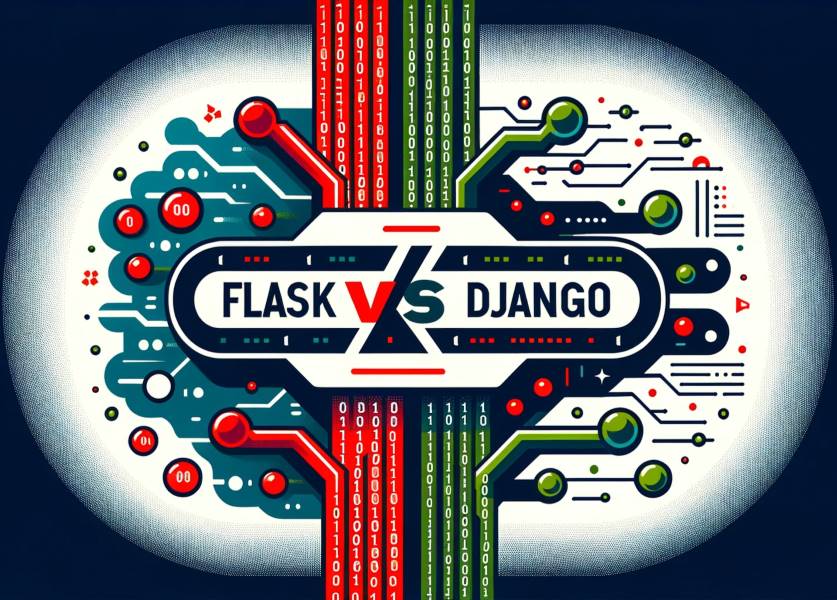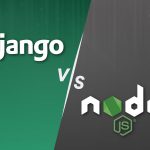Flask vs Django: A Comprehensive Analysis To Make The Right Choice

Flask and Django are two Python frameworks within the Python ecosystem that are dominating modern web development. They’ve garnered immense popularity, sparking a debate on which one to wield for your next project. Both excel in various areas, but they also differ in some respects, making a detailed comparison necessary to identify the best of them.
Flask caters to the contemporary needs of web app development and comes out favorite for small scale needs. On the other hand, Django comes as a comprehensive full-stack framework that presents to developers an all-encompassing toolkit for building robust applications.
While Django may be seen as the go-to choice, it may not be the case always, as Flask shines in specific scenarios. Factors like project size, time-to-market pressure, and the need for stability play pivotal roles in this decision-making process.
As you try to pick one of these two peas in a pod, we come to your assistance by bringing you insights inclusive of every detail around them. By helping you fairly understand the actual difference between Django and Flask, the discussion sheds light on when to opt for one over the other.
Drawing the Flask vs Django comparison for making the right selection
As we venture to choose between Django and Flask, two popular Python frameworks, we inspect each of them by diving into their basics, features, and benefits. We weigh in on various parameters to draw a useful comparison. With the facts at our disposal, we will proceed to offer our verdict on whether it’s Django or Flask. Let’s start with Flask.
What is Flask?
Flask is a lightweight web framework, offering a simplified approach to building applications. Developed by Armin Ronacher, it’s considered a microframework that emphasizes a small core and efficiency. It is built on WSGI and Jinja2 and streamlines tasks like handling HTTP requests, rendering templates, and managing routes.
What are the Features of Flask?
As a versatile Python web framework, Flask boasts multiple features that demonstrate its capabilities as a potent tool for modern-day development needs. Uncovering these features, we examine them to gauge Flask’s strength:
- Flask’s routing system allows developers to define URL patterns and associate them with specific functions or views, so mapping incoming HTTP requests to the appropriate code for processing becomes easy.
- As a web application framework, Flask provides mechanisms to handle different types of HTTP requests, such as GET (for fetching data), POST (for submitting data), PUT (for updating data), DELETE (for deleting data), and more.
- It can integrate with the Jinja2 template engine, which aids in building HTML templates with placeholders for dynamic content. Flask then renders these templates with specific data, separating logic and presentation.
- Flask is a framework that includes a built-in development server, which is a lightweight web server designed for testing and debugging during the development process.
- Developers use Flask to create dynamic routes by defining variables within the URL pattern. These variables are extracted and passed as arguments to the associated view function.
- Flask provides a session object that allows developers to store and retrieve data for a user across multiple requests.
- The framework offers mechanisms for handling various types of errors, such as 404 Not Found or 500 Internal Server Error. Developers can define custom error pages to provide user-friendly error messages.
- Using decorators like @app.route, Flask allows developers to specify which HTTP methods a view function should respond to (e.g., @app.route(‘/submit’, methods=[‘POST’])).
- Includes support for handling file uploads from HTML forms. Developers can access uploaded files through the request.files object.
- As a comprehensive web framework, it allows the serving of static files (e.g., CSS, JavaScript, images) directly from a designated folder. Improving performance, the step avoids the need to route these requests through code.
- Built on top of the Werkzeug library, which provides low-level utilities for handling HTTP requests and responses, Flask includes features like request parsing and response generation.
- While Flask is minimalist, developers can use middleware to intercept and modify requests and responses.
- Flask itself does not come with an Object-Relational Mapping (ORM) system, but it integrates seamlessly with popular ones like SQLAlchemy and Flask-SQLAlchemy.
- Providing a rich ecosystem of extensions and plugins that add pre-built functionality to applications, Python Flask offers features for various tasks.
- With extensions like Flask-RESTful, Flask can be used to build APIs that adhere to RESTful principles, making it easier to create web services.
- Flask includes a built-in debugger that allows developers to inspect variables, set breakpoints, and step through code. It also supports profiling, which helps identify performance bottlenecks.
- The web framework provides tools for implementing security features like Cross-Site Request Forgery (CSRF) protection and secure password hashing.
- Flask includes support for handling multiple languages and locales, making it easier to create applications that cater to a global audience.
- Flask can be extended to support WebSocket communication using libraries like Flask-SocketIO, important for real-time, bidirectional communication between the server and clients.
- Flask offers robust testing features, including a built-in test client, context management, and assertions for HTTP responses, enabling effective unit and integration testing of web applications.
What is Django?
Django is a powerful, high-level Python web framework built by Adrian Holovaty and Simon Willison. It fosters the swift and secure development of web applications by adhering to the “batteries-included” approach. This means that Django offers a comprehensive set of pre-built components for tasks like database management, authentication, and URL routing.
What are the Features of Django?
As a popular Python web application development framework, Django offers a spectrum of features that are considered the best among parallel frameworks for web development. We dive into these features, to understand what distinguishes Django:
- Django’s URL dispatcher maps URLs to specific view functions. It uses regular expressions to match incoming requests and directs them to the appropriate view for processing.
- The object-relational mapping layer (ORM) is a powerful abstraction layer that allows developers to interact with the database using Python objects. Models are defined as Python classes, making it easier to work with databases without writing raw SQL.
- As a Python web framework, Django provides a built-in authentication system for user management. It includes features like user registration, login, logout, and password reset.
- The template engine (Django Template Language or DTL) allows the separation of HTML from Python code. It supports template inheritance, filters, loops, conditional statements, and dynamic content rendering.
- The powerful form handling system helps a Django developer easily create forms that can be easily created, validated, and processed. This feature is important for user input handling and data validation.
- Django’s migration framework automates the process of managing database schema changes. It tracks changes to models and generates SQL code to apply those changes to the database.
- Built-in security features offered by the Django framework include protection against common web vulnerabilities like Cross-Site Scripting (XSS), Cross-Site Request Forgery (CSRF), and SQL injection.
- Providing tools for handling user sessions, Django allows data to be stored and retrieved across multiple requests, and sessions can be stored in cookies or server-side.
- Django’s caching framework proves vital for storing of frequently accessed data in memory, reducing the need for repeated computations or database queries.
- Utilities offered by Django framework for handling file uploads and storage, effortlessly manages file uploads, including validation, storage, and retrieval.
- Django is a framework that offers built-in support for multiple languages and locales, so easy translation and adaptation for different regions is possible.
- Django provides a comprehensive testing framework for writing and executing tests, thereby conforming to code quality standards.
- The framework allows developers to assign names to URLs, making it easier to reference them in templates and view functions.
- Django provides built-in support for paginating large datasets, allowing for the efficient display of a limited number of records per page, improving user experience.
- Middleware components can be added to the request/response processing pipeline. They can intercept and modify requests and responses.
- Class-Based Views in Django use Python classes for view handling, enabling code reusability, and organization, and simplifying complex view logic for improved maintainability and scalability.
- The web framework provides a built-in mechanism for handling background tasks, making it easy for developers to offload time-consuming or non-critical tasks. The feature is particularly useful for tasks like sending emails and processing large data sets.
- Django includes a Geographic Information Systems (GIS) framework for working with geographic and spatial data.
- The admin interface of Django is a powerful, extensible tool for managing application data. It is generated automatically based on the application’s models, providing an intuitive web-based dashboard for performing CRUD operations.
- Native support for asynchronous programming comes in handy for handling asynchronous requests and multiple tasks concurrently, especially for web apps with heavy I/O operations.
Notable Benefits of Flask
Enlisted below are some benefits of Flask that make developers heavily leverage it in their web application development projects:
- Offers Lightweight and Simple: Flask is designed to be minimalistic and lightweight and is therefore easy to implement in a web development project. Developers can choose and integrate only the components they need, and so, Flask is suitable for small to medium-sized applications.
- Flexibility and Customization: Providing a great level of flexibility, Flask encourages developers to choose their own libraries and tools. So, they can pick up and choose components based on the project’s specific requirements.
- Microservices and APIs: Flask is particularly suitable for building microservices and APIs, and so is an excellent choice for applications that need to handle a large number of API requests efficiently.
- Learning Curve: Flask is better at offering a relatively low learning curve compared to more comprehensive frameworks like Django. This aspect of Flask proves particularly beneficial for developers who are new to web development or who prefer a more hands-on approach to building web applications.
- Extensible: The framework is designed to be extensible, meaning developers can add functionality as needed using third-party extensions. Developers can thus build their applications in a modular fashion, only including what they need.
Notable Benefits of Django
A powerful framework, Django benefits the web development process in innumerable ways, as we look at some of its significant benefits.
- Performance Optimization: Django’s performance optimization capabilities are well-known, and are present in various options it provides. It comes with various tools to handle high-traffic loads and optimize code for better performance.
- Time-Tested and Battle-Tested: Developers use Django for its maturity and stability, and it has been used in numerous high-traffic, production-level applications, which attests to its reliability and scalability.
- Community Packages: Django provides a rich ecosystem of third-party packages, which can be easily integrated into projects, so developers can extend the functionality of an application without reinventing the wheel.
- Pluggable Architecture: The pluggable app system arms developers with immense capability to compartmentalize functionalities into independent modules.
- Consistent Project Structure: Enforcing a consistent project structure, Django helps developers easily navigate and understand the codebase. The uniformity makes it simpler for multiple developers to collaborate on a project or for a developer to work on different Django projects.
Flask vs Django: Comparison across Parameters Summarizing Results
We culminate the insights obtained above into an impeccable Django vs Flask comparison so that you finally understand which framework excels in which respect. Remember, the communities of both frameworks are highly developed and constantly working to bring improvements, so, across the parameters, the performance of each framework may not remain the same (it is likely to improve, and this analysis just draws a comparison to make your selection decision easy).
| Parameter | Flask | Django | Winner |
| Ease of Learning | Flask is lightweight and easy to learn. It’s a micro-framework, providing flexibility for developers to add components as needed. | Django has a steeper learning curve due to its comprehensive nature. It includes a lot of built-in features, which can be overwhelming for beginners. | Flask |
| Flexibility | Flask framework provides more flexibility as it’s a micro-framework. Developers can choose components and libraries according to their needs. | Django is more opinionated and comes with a set of built-in components. This can be limiting in some cases but speeds up development for common use cases. | Depends on preference and project requirements |
| Scalability | Flask is more lightweight and can be more suitable for small to medium-sized applications. It allows you to choose components based on scalability needs. | Django is designed to handle larger and more complex applications out of the box. It provides a built-in admin interface and ORM which can be useful for larger projects. | Django |
| Community & Ecosystem | Flask has a smaller community compared to Django, but it’s still active and growing. It has a wide range of extensions and libraries available. | Django has a large and active community with a rich ecosystem of plugins, packages, and resources. It’s well-established and widely used in the industry. | Django |
| Built-in Features | Flask is minimalist, providing only essential features. Developers need to add extensions and libraries for features like authentication, admin interface, etc. | Django provides a wide range of built-in features including an admin interface, authentication, ORM, forms handling, and more. | Django |
| URL Routing | Flask uses a simple routing system, which requires manual configuration of routes. | Django has a powerful URL routing system that automatically maps URLs to views based on patterns defined in the project’s URL configuration. | Django |
| ORM (Object-Relational Mapping) | Flask doesn’t include an ORM by default, but there are popular extensions like SQLAlchemy available. | Django includes its own ORM (Django ORM) which is powerful and widely used. | Django |
| Template Engine | Flask allows developers to choose their preferred template engine. Jinja2 is commonly used. | Django includes its own template engine, which is tightly integrated with the framework. | Depends on preference and project requirements |
| Admin Interface | Flask doesn’t have a built-in admin interface, but there are extensions available like Flask-Admin. | Django comes with a powerful admin interface for managing application data. | Django |
| Security | Flask leaves security implementation to the developer, which means developers need to be mindful of best practices. | Django provides a number of built-in security features, including protection against common web vulnerabilities. | Django |
| Micro-framework | Flask is a micro-framework, providing only the essential components needed for building web applications. It allows developers to choose and integrate components as per their requirements. | Django is a full-stack framework that comes with a set of built-in features and components, which may not be necessary for all projects. | Flask |
| RESTful API Development | Flask is excellent for building RESTful APIs. It allows developers to easily create lightweight and efficient APIs using extensions like Flask-RESTful. | Django also supports API development, but it may be considered overkill for projects that primarily focus on building APIs without the need for a full-fledged web application. | Flask |
| Modularity | Flask’s modular design allows developers to add or remove components based on project requirements. This means you have more control over the architecture of your application. | Django has a more monolithic structure, which means developers may have less flexibility in choosing which components to use. | Flask |
Also Read: Django Vs NodeJS
Use Finoit’s Python Expertise to Best Use Flask and Django
We delved into the details of differences between Flask and Django, which is sure to empower you with a comprehensive understanding of when you should use which of these frameworks. By providing a thorough analysis, you can now confidently discern whether it’s Flask or Django that aligns best with their project requirements.
Flask shines in its simplicity and flexibility, making it ideal for small to medium-scale applications, while Django’s robustness and built-in features make it a powerhouse for larger, complex projects.
For businesses, the decision of which framework to use now rests on a solid foundation of knowledge and skills in each. As these are special frameworks, seeking the assistance of experts remains invaluable for maximizing your web application’s potential using these powerful Python frameworks.

